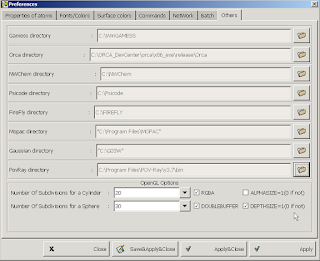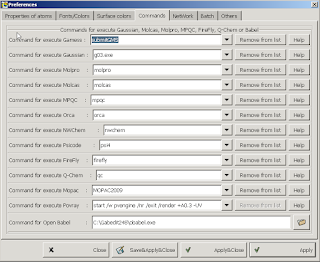Quite a while back I was looking at the WAH (Wilson-Amos-Handy) functional, and while it turned out to be a bit more complicated than I had hoped, it led me to type up a brief discussion about b3lyp in different computational packages.
The issue is that there are several different definitions, and that even if a paper is kind enough to provide the Becke 1993 communication as a reference, this is rarely the actual form of b3lyp used. In fact, the LYP part would speak directly against it. As someone whom isn't well-versed in the computational and theoretical arts I do think it would be nice if we could get to the point where we can get useful information by doing point-and-click computations, but as exchange-correlation functionals essentially are fudge-factors, this probably won't happen for some time. In other words, 6-31G/B3LYP may be a winning combination for the computation of electronic energies of a limited range of (mostly organic) small molecules in the gas phase, it doesn't always yield anything useful about real-world systems.
NOTE: I wrote the original text as I was trying to figure out what WAH was -- and I thought at that point that it was a simple form of B3PW91 with tweaked prefactors. It isn't -- it's requires changes in the way the GIAOs are computed (I think). So don't focus on the WAH discussion.
Anyway, here's the story as a bench chemist (i.e. not a computational or theoretical chemist) understands it, in the context of trying to understand what the WAH exchange-correlation functional looks like.
The WAH functional is a hybrid exchange correlation functional which was developed to provide accurate NMR shift calculations.
Note that the WAH functional is correctly implemented in
PQS -- see the
manual.
But the story is really about
B3LYP...
1. Definition of the WAH exchange-correlation functional:
The definition[1] consists of
We found that by using hybrid Kohn-Sham orbitals and eigenvalues with an adjusted 'exact-exchange' coefficient Cx, the NMR shielding parameters gave an accuracy approaching the best coupled-cluster calculations for molecules containing first and second row atoms. For B3LYP[2] we find Cx=0.05[..] give(s) best values (note that the coefficient of Local Density Exchange is (1-Cx) in the amended B3LYP. We name the resulting NMR values B3LYPGGA0.05[..].
This is the paper which is cited by the PQS manual. The definition is brief, but not unreasonable.
2 Definition of B3LYP
[The first-person account of the background to B3LYP is found here:
http://www.ccl.net/chemistry/resources/messages/2002/05/22.008-dir/]
In the paper which is cited as a source of
B3LYP, Becke defined[2] a functional as
EXC=EXCLSDA+a0 (ExHF-ExLSDA )+axΔ ExBecke88+acΔ EcPW91 (eq 1)
where E
XC denotes exchange-correlation functional, E
x denotes exchange functional, E
c denotes correlation functional, Δ denotes non-local contribution,
LSDA is the local spin-density approximation,
Becke88[3] is the gradient-corrected
LDA and
PW91 is the Perdew-Wang 1991 gradient correction.[4]. The B3 in B3LYP refers to the three parameters it involves: a
0=0.2, a
x=0.72 and a
c=0.81. Note that a
0 is the same as C
x above. We'll refer to
equation 1 as
B3PW91.
LSDA is poorly defined but is normally taken to be the
SVWN of the form
EXCLSDA=EXLSDA+ECLSDA (eq 2)
=ExSlater+EcVWN (eq 3)
although there's a slew of Vosko-Wilk-Nusair (
VWN) functionals -- most sources suggest that Becke referred to
VWN5, while my reading of the literature is a bit different (Becke states he uses the electron-gas parametrization in [4]).
Either way,
equation 1 now becomes
EXC=a0 ExHF+(1-a0 )ExSlater+EcVWN +axΔ ExBecke88+acΔ EcPW91 (eq 4)
This is implemented as the hybrid exchange-correlation functional
acm in NWChem (the
adibatic connection method) using VWN5.
A very brief summary of
Becke '93 vs Gaussian '92 (don't ask me about the chronology) is also available by Stephens
et al. in
J. Phys. Chem. 1994, 98(45), p. 11624.
2.1 Gaussian '92
You may at this point be forgiven for asking yourself why it is called
B3LYP and not
B3PW91. In 1991 Gaussian hadn't yet implemented
PW91 (fair enough) and substituted it with the Lee-Yang-Parr (
LYP) correlation functional (
ΔEcLYP). Since it's difficult to separate the local component (and we want the non-local component as indicated by
Δ), they wrote
Δ EcLYP=EcLYP-EcVWN (eq 5)
which turns
equation 4 into
EXC=a0 ExHF+(1-a0)ExSlater+axΔ ExBecke88+acEcLYP +(1-ac)EcVWN (eq 6)
In addition, in the original Gaussian implementation
VWN_1_RPA was used, which sources tell me is 100\% wrong when taking Becke's intentions into account.
EXC=a0 ExHF+(1-a0)ExSlater +axΔ ExBecke88+acEcLYP +(1-ac)EcVWN_1_RPA (eq 7)
To make matters worse, today Gaussian uses
VWN_3 and it seems they know how to get the nonlocal component of
LYP directly (see below).
Equation 7 is what you use if you use
B3LYP in most software packages (though not all -- e.g.
Gamess US uses
VWN5 instead of
VWN_1_RPA)
So in
G09 it's now
EXC=a0 ExHF+(1-a0)ExSlater+axΔ ExBecke88+EcVWN_3+acEcLYP (eq 8)
2.2 PQS
PQS uses the old gaussian version (eq. 7) as the b3lyp functional, but it doesn't explicitly state which form -- b3lyp or b3pw91 -- is used for the WAH functional.
3 So what definition did WAH use?
All we really care about is reproducing the original paper by Handy
et al. -- not whether Becke would approve or not. But here's where the problem of citing papers you may not have read becomes an issue.
Wilson, Amos and Handy cite the 1993 paper by Becke which defines the canonical version of B3LYP (i.e. B3PW91), which should settle it in favour of WAH being defined as shown in
equation 4.
However, they used CADPACK, which implements it as in
equation 7.
Reading the CADPACK manual I can see what Handy
et al. probably did: the way you define custom parameters for hybrid functionals in CADPACK is by doing
hybrid a0 ax ac
so that they during the development of their functional most likely typed in
b3lyp 0.05 0.72 0.81
which meant they probably used
EXC=0.05 ExHF+0.95 ExSlater+ +0.72 Δ ExBecke88+0.81 EcLYP +0.19 EcVWN_1_RPA (eq 9)
4 Implementing it in your package of choice
[NOTE: this will NOT set up WAH correctly -- I'm leaving it as it shows how to set up custom XCs in nwchem, G09 and Dalton]
4.1 NWCHEM
The canonical version of Becke's functional, B3PW91, is implemented as
acm in NWChem and which is manually entered as
xc HFexch 0.2 slater 0.8 becke88 nonlocal 0.72 vwn_5 1 Perdew91 0.81
while the Gaussian '92 form is manually entered as
xc HFexch 0.2 slater 0.8 becke88 nonlocal 0.72 vwn_1_rpa 0.19 lyp 0.81
This means that the two possible forms of WAH are:
xc HFexch 0.05 slater 0.95 becke88 nonlocal 0.72 vwn_5 1 Perdew91 0.81
and
xc HFexch 0.05 slater 0.95 becke88 nonlocal 0.72 vwn_1_rpa 0.19 lyp 0.81
We'll refer to them as B3PW91
0.05 and B3LYP
0.05, respectively.
4.2 Gaussian 09
Gaussian is a lot less elegant.
The canonical version of Becke's functional, B3PW91, is implemented as
acm in Gaussian as B3PW91, which is manually entered as
BPW91 IOp(3/76=1000002000) IOp(3/77=0720008000) IOp(3/78=0810010000)
while the old Gaussian form is manually entered as
BLYP IOp(3/76=1000002000) IOp(3/77=0720008000) IOp(3/78=0810001900
This means that the two forms of WAH are:
BPW91 IOp(3/76=1000000500) IOp(3/77=0720009500) IOp(3/78=0810010000)
and
BLYP IOp(3/76=1000000500) IOp(3/77=0720009500) IOp(3/78=0810001900)
We'll refer to them as B3PW91
0.05 and B3LYP
0.05, respectively.
4.3 Dalton
The notations are (more or less)
Combine HF=0.20 Slater=0.80 Becke=0.72 PW91c=0.81 VWN5=1
Combine HF=0.20 Slater=0.80 Becke=0.72 LYP=0.81 VWN=0.19
Combine HF=0.05 Slater=0.95 Becke=0.72 PW91c=0.81 VWN5=1
Combine HF=0.05 Slater=0.95 Becke=0.72 LYP=0.81 VWN=0.19
As an aside, I don't think anyone at this point would be surprised to learn that
B3PW91 in Dalton and Gaussian are two completely different exchange-correlation functionals...
Performance
NOTE: the results don't quite make any sense to me anymore -- using the same XCs and basis sets and structures one would expect to get the exact same results for all three packages. I don't know why that wasn't the case, assuming that I implemented the XCs correctly, and assuming that the basis sets really are the same (which often they actually aren't...). So keep that in mind.
Original:
I used the same equilibrium structures as Handy (i.e. those of Cybulski), and used the aug-cc-pVTZ basis set with a fine DFT grid (not the same as Handy -- but should be as good. Also, I've done this with def2-qzvp and 6-31+g* as well). All calculations are for the gas phase. Handy's values are for the Huzinaga IV basis set in their GIAO paper[5], but it doesn't really matter much which basis set is chosen. The results are tabulated in table 1.
Note that Handy also saw chemical shifts for the oxygen in carbon monoxide which were around -80 ppm. Basically, I can reproduce everything except for his B3LYP
0.05gga. I did a few test-runs with Huz-IV in Dalton and it was just as bad as the other methods.
Table 1:
Tabulated calculated gas phase NMR shifts using different combinations of exchange-correlation functionals and the aug-cc-pvtz basis set. Note that Handy's experimental data are not in agreement with my sources, which are 1.0, -42.3 and 344 ppm for CO, CO and H2O, respectively.
| Package |
b3lypa |
gb3lypb |
acmc |
b3pw91b |
b3lyp0.05 |
b3pw910.05 |
Handy |
Expt. |
| Carbon in CO (ppm) |
|
|
|
|
|
|
|
|
| NWChem |
-10.32 |
-10.32 |
-8.80 |
-8.80 |
-8.08 |
-6.55 |
5.6 |
2.8 |
| G09 |
-7.71 |
-7.71 |
-9.95 |
-9.95 |
-5.66 |
-7.74 |
|
|
| Dalton |
-10.21 |
-10.21 |
N/A |
-12.65 |
-7.97 |
-10.38 |
|
|
| Oxygen in CO (ppm) |
|
|
|
|
|
|
|
|
| NWChem |
-71.51 |
-71.51 |
-72.34 |
-72.34 |
-70.06 |
-70.93 |
-40 |
-36.7 |
| G09 |
-78.82 |
-78.82 |
-77.89 |
-77.89 |
-77.57 |
-76.86 |
|
|
| Dalton |
-71.50 |
-71.50 |
N/A |
-72.03 |
-70.04 |
-70.89 |
|
|
| Oxygen in water |
|
|
|
|
|
|
|
|
| NWChem |
328.45 |
328.45 |
329.28 |
329.28 |
329.79 |
330.48 |
327 |
358 |
| G09 |
N/A |
328.76 |
328.39 |
328.39 |
328.95 |
328.31 |
|
|
| Dalton |
328.50 |
328.50 |
N/A |
328.02 |
329.85 |
329.07 |
|
|
aNote that G09 uses eq. 8 by default (gives -11.70, -77.63, and 328.34 ppm), but I forced it to use eq. 7. b These were my manual implementations of 'b3lyp' and 'acm' to make sure I got things right. c This is acm in NWChem and B3PW91 in Gaussian 09.
|
References:
[1] P. J. Wilson, R. D. Amos, H. N. C., Chem. Phys. Letters 1999, 321, 475-484.
[2] A. D. Becke, J. Chem. Phys. 1993, 98, 5648-5652.
[3] A. D. Becke, Phys. Rev. A 1988, 38, 3098-3100.
[4] J. P. Perdew, Y. Wang, Phys. Rev. B 1991, 45, 13244-13249.
[5] T. Helgaker, P. J. Wilson, R. D. Amos, N. C. Handy, J. Chem. Phys. 2000, 113, 2983-2989.




















































